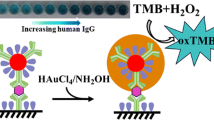Abstract
Luminescent 50-nm silicon dioxide nanoparticles containing both types of rhodamine 6G (R; particles denoted R-SiO2) were synthesized by the sol–gel method. In the presence of Pb(Ac)2 as a heavy atom perturber the particle can emit the intense and stable room-temperature phosphorescence (RTP) signal of R on a polyamide membrane, with λ maxex /λ maxem =470/635 nm for R. Our research indicates that the specific immune reaction between goat-anti-human IgG antibody labeled with R-SiO2 and human IgG can be carried out quantitatively on a polyamide membrane, and the phosphorescence intensity was enhanced after the immunoreaction. Thus a new method for solid-substrate room-temperature phosphorescence immunoassay (SS-RTP-IA) for determination of human IgG was established on the basis of antibody labeled with the nanoparticles containing binary luminescent molecules. The linear range of this method is 0.0624–20.0 pg spot−1 of human IgG (corresponding to a concentration range of 0.156–50.0 ng mL−1, sample volume 0.40 μL spot−1). The regression equations of the working curves are ΔIp=71.27+7.208mIgG (pg spot−1) (r=0.9996). Detection limits calculated as 3Sb/k are 0.022 pg spot−1. Compared with the same IA using fluorescein isothiocyanate (FITC) as the marker the new method was more sensitive and had a wider linear range. After elevenfold replicate measurement RSD are 4.5 and 3.6% for samples containing 0.156 and 50.0 ng mL−1 IgG, respectively. This method is sensitive, accurate, and of high precision.





Similar content being viewed by others
References
Liu JM, Yan F, Yu BB, Li LD (2001) Chem J Chin Univ 22:1645–1648
Yan F, Yu BB, Li LD, Liu JM (2002) Anal Chim Acta 470:121–127
Richard PH (1996) In: Michelle TZ (ed) Handbook of fluorescent probes and research chemicals, 6th edn. Molecular Probes Inc., Spence, pp 107–116
Sun BQ, Yi GS, Zhao SY, Chen DP, Zhou YX, Cheng J (2001) Anal Lett 34:1627–1637
Guan Z (1998) Chemistry 12:57
Chan CW, Nie SM (1998) Science 281:2016
Zhu ZY (1992) Practical medical laboratory technology. People Military Surgeon Press, Beijing, p 810
Wei YS, Jin WJ, Yang Y, Liu CS (1998) Chin J Anal Chem 26:515–519
Lin YX (1980) Immunology foundation, Science and Technology Press of Fujian, Fuzhou, p 30
Acknowledgements
This work was supported by the Chinese National Natural Science Foundation (Grant No. 20175011) and Fujian Province Natural Science Foundation (Grant No. C0110028).
Author information
Authors and Affiliations
Corresponding author
Rights and permissions
About this article
Cite this article
Liu, JM., Yang, TL., Liang, XS. et al. Determination of human IgG by solid-substrate room-temperature phosphorescence immunoassay based on an antibody labeled with nanoparticles containing rhodamine 6G luminescent molecules. Anal Bioanal Chem 380, 632–636 (2004). https://doi.org/10.1007/s00216-004-2767-y
Received:
Revised:
Accepted:
Published:
Issue Date:
DOI: https://doi.org/10.1007/s00216-004-2767-y




